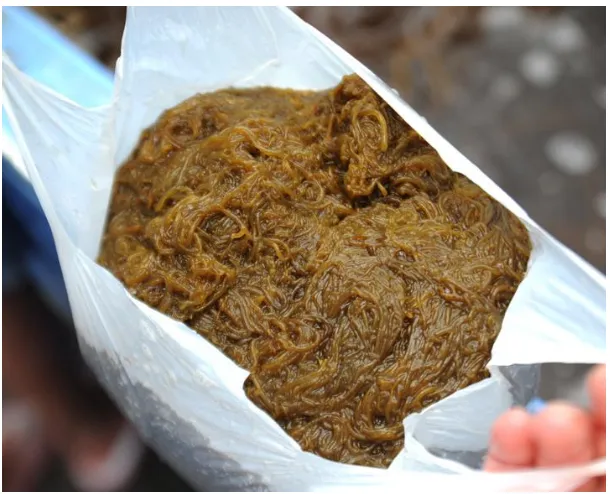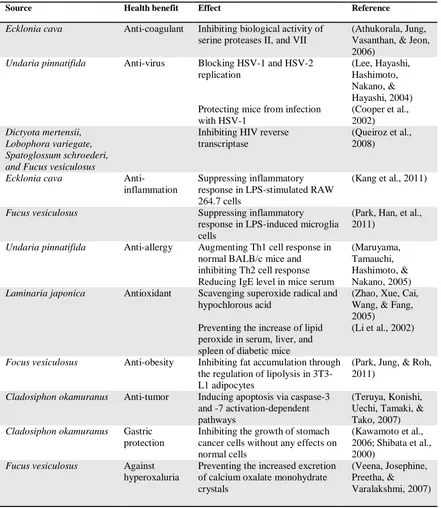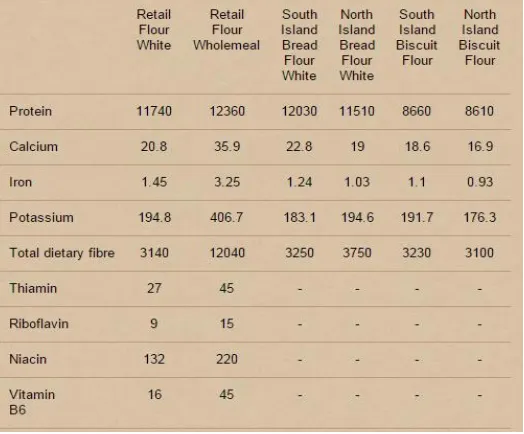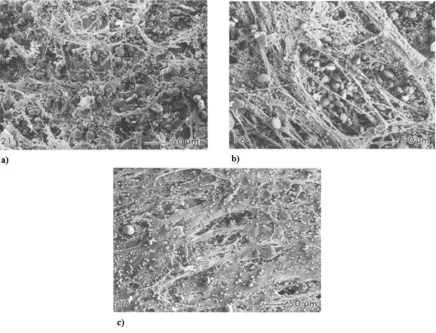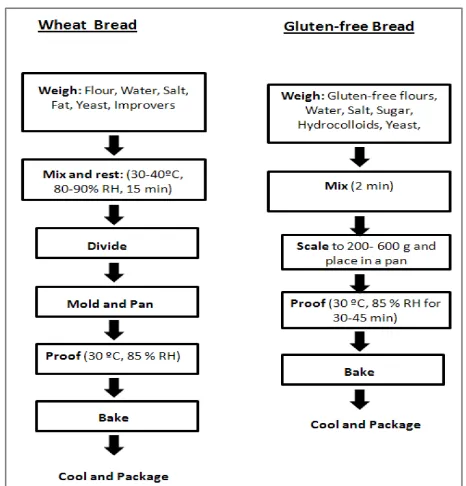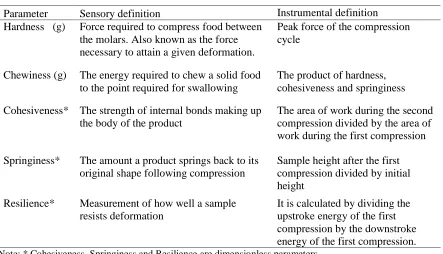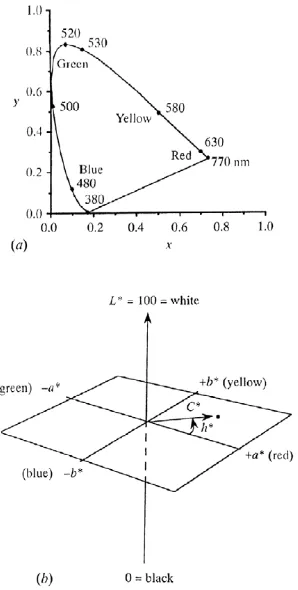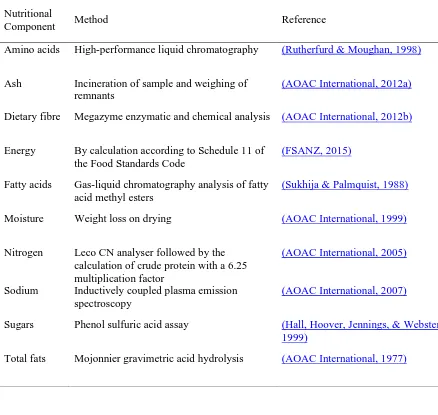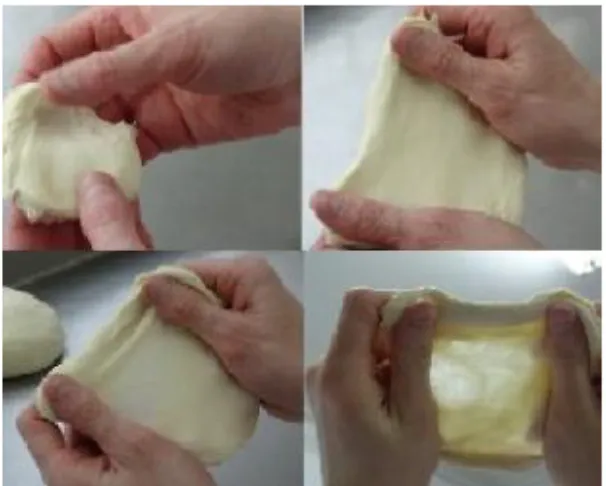Copyright is owned by the Author of the thesis. Permission is given
for a copy to be downloaded by an individual for the purpose of
research and private study only. The thesis may not be reproduced
Development of bread products containing Chordaria
cladosiphon (Mozuku) and its bioactive extract fucoidan
A thesis presented in partial fulfilment of the
requirements for the degree of
Master of Food Technology
at Massey University, Albany,
New Zealand
Stephen Daniel Grubb
i
Abstract
Many seaweeds such as Chordaria cladosiphon, commonly known as mozuku, have been shown to contain several health promoting components such as dietary fibres, antioxidants, and a range of bioactive compounds. Mozuku is an edible brown seaweed which constitutes an important part of the diet of native Okinawans who enjoy long lives and consume the seaweed mixed with various seafoods and vegetables. Brown seaweeds and their isolated compounds, specifically a long-chain polysaccharide known as fucoidan, are reported to retard the formation and growth of various cancer cells in humans as well as having anticoagulation, antiviral and immunological activities. The present study developed wheat and gluten-free bread formulations containing mozuku powder in order to introduce its potential health effects into a staple food product thus making it more accessible to a wider range of consumers.
Nutritional analysis of mozuku powder was determined by proximate analysis, fatty acid analysis and amino acid analysis, particle size distribution of the powder was also determined. Mozuku powder was added to modified wheat bread and developed gluten-free bread formulations with adjustments in levels of added salt. The effects of mozuku powder inclusion on bread quality were assessed by measuring changes in bread quality parameters, with standard methods being used to determine texture characteristics, crust and crumb colour, specific volume and water activity. Samples of gluten-free and wheat bread were evaluated by consumer sensory panellists for appearance, texture, aroma, taste, and overall acceptability using the 9-point hedonic scale. Microbial stability of wheat bread was determined by enumeration of total aerobic plate counts and, yeast and mould counts over the course of 3 days.
ii Addition of mozuku powder to both gluten-free and wheat bread formulations with adjusted salt levels, reduced specific volume and breadcrumb lightness of the products without affecting water activity. However, inclusion of the seaweed powder in formulations increased redness/yellowness in the bread crumb. There were no significant differences (P<0.05) in textural changes between wheat bread containing 1 and 2 % mozuku powder. However, wheat bread containing 2 % mozuku powder was characterised by decreased cohesiveness with no perceived changes in hardness, chewiness, resilience and springiness. Wheat bread containing 1% and 2% mozuku powder were well accepted by consumer sensory panellists receiving mean scores of 6.8 and 6.4 in overall acceptability on the 9-point hedonic scale. The addition of mozuku powder to wheat bread at 1% and 2% did not affect the microbial stability of the loaves during storage at 20°C for 3 days. With respect to gluten-free bread formulations, mozuku powder (up to 3%) did not affect texture (P<0.05), however, the inclusion of 4% mozuku powder in free bread increased hardness, chewiness and resilience. The gluten-free formulation containing a concentration of 2.5% mozuku powder was selected for consumer sensory trials due to its favourable quality results and received a mean score of 6.4 in overall acceptability on the 9-point hedonic scale thus indicating the product was well-liked by consumer sensory panellists.
iii
Acknowledgements
I would like to acknowledge and thank Glenorie International Ltd. offering the opportunity and financial support to carry out this study.
It has been an amazing experience pursuing my post-graduate studies in Food Technology at Massey University. This thesis was made possible due to the help and guidance of a number of individuals based both at Massey University Albany campus and from external companies who provided their knowledge and expertise in both post-graduate academic research and industrial product development.
I would like to thank the following individuals:
My Massey University supervisors Dr. Tony Mutukurmira, and Associate Professor Kay Rutherfurd-Markwick, who have provided me with support, not only in the technical aspects of my research but also with guidance in handling the entirety of my post-graduate studies. Alan Smith whose wise words, enthusiasm for research and development, and generosity has
made this entire project possible
• Tim Grainger of Venerdi Ltd who kindly provided materials and advice regarding the development of GF bread which has greatly assisted the progressing of this study
• Rachel Liu and Kenneth Teh, for organizing equipment, and materials and general guidance throughout testing.
iv
Table of Contents
Abstract ... i
Acknowledgements ... iii
Table of Contents ... iv
List of Figures ...vii
List of Tables ... ix
List of Abbreviations ... x
1 Introduction ... 1
1.1 Aim ... 3
1.2 Specific objectives ... 3
2 Literature Review ... 4
2.1 Introduction ... 4
2.2 Mozuku ... 5
2.2.1 Introduction ... 5
2.2.2 Current seaweed market ... 6
2.2.3 Food standards and safety... 7
2.2.4 Nutritional content ... 8
2.3 Fucoidan ... 12
2.3.1 Introduction ... 12
2.3.2 Structure and stability ... 12
2.3.3 Digestion and absorption ... 16
2.3.4 Health effects... 16
2.4 Bread making ... 20
2.4.1 Introduction ... 20
2.4.2 Nutrition ... 21
2.4.3 Bread types ... 22
2.4.3 Trends in the bakery industry ... 23
2.4.4 Bread components ... 24
2.4.5 The science and technology of bread making ... 35
2.4.6 Gluten-free bread production ... 39
2.4.7 Shelf life and spoilage ... 41
2.6 Analysis techniques ... 43
v
2.6.2 Colour... 46
2.6.3 Loaf volume ... 47
2.6.6 Sensory evaluation ... 48
2.6.4 Moisture and water activity ... 48
2.6.6 Microbial growth ... 49
2.7 Summary ... 50
3 Materials and Methods ... 51
3.1 Introduction ... 51
3.2 Ingredients used in bread formulations ... 51
3.1 Analysis of mozuku powder ... 52
3.1.1 Nutritional analysis ... 52
3.1.2 Mesh size analysis of mozuku powder ... 53
3.2 Production of wheat bread with added mozuku powder ... 54
3.2.1 Approach ... 54
3.2.3 Production of wheat bread ... 56
3.3 Development and production of gluten-free bread with added mozuku powder ... 59
3.3.1 Experimental design ... 59
3.3.2 Production of gluten-free bread ... 62
3.4 Tests conducted on wheat and gluten-free breads... 63
3.4.3 Determination of specific volume ... 63
3.4.1 Texture profile analysis –Double Compression Test ... 63
3.4.2 Analysis of crust and crumb colour ... 63
3.4.4 Determination of water activity ... 64
3.5 Consumer sensory evaluation ... 64
3.5.1 Introduction ... 64
3.6 Microbial stability ... 65
3.7 Analysis of data ... 66
4 Results and Discussion ... 67
4.1 Analysis of mozuku powder ... 67
4.1.1 Analysis of nutritional content ... 67
4.1.2 Mesh size analysis ... 72
4.2 Wheat bread ... 73
4.2.1 Product formulation ... 73
vi
4.2.3 Microbial stability ... 82
4.3 Gluten-free bread... 83
4.3.1 Base formulation ... 83
4.3.2 Inclusion of mozuku powder ... 91
4.3.3 Consumer evaluation ... 99
4.4 Limits of study and future research ... 102
5 Summary ... 103
6 Conclusion ... 104
7 Recommendations ... 105
References ... 106
Appendices ... 123
Appendix A ... 123
Appendix B ... 127
Appendix C ... 135
Appendix D ... 138
Appendix E – Descriptive statistics of mesh size analysis ... 147
Appendix F – Wheat bread microbial data and analysis ... 148
Appendix G-I – Statistical analysis of wheat bread ... 151
Appendix G-2 – Phase I statistical analysis of gluten-free bread ... 172
Appendix G-3 – Phase II statistical analysis of gluten-free bread ... 182
vii
List of Figures
ix
List of Tables
Table 2.1 Various polysaccharides found in seaweed species ... 9
Table 2.2 Vitamin contents of various red, green and brown seaweed species. ... 10
Table 2.3 Fibre and carbohydrate nutritional values from various seaweeds and food products ... 12
Table 2.4 Overview of biological activities of fucoidans from a range of brown seaweeds ... 17
Table 2.5 Nutritional properties of New Zealand white wheat flours (mg per 100g)... 21
Table 2.6 Water activities at which various pathogenic and spoilage microorganisms grow ... 42
Table 2.7 Texture parameters used in the texture profile analysis of bread ... 45
Table 3.1a Ingredient composition of wheat bread ... 52
Table 3.1b Ingredient composition of gluten-free bread ... 52
Table 3.2 Analytical methods used in the analysis of the nutritional content of mozuku powder .... 53
Table 3.3 Base formulation for standard wheat bread ... 56
Table 3.4 Base formulations of gluten-free bread ... 61
Table 4.1 Macronutrient analysis of freeze-dried mozuku powder ... 67
Table 4.2 Proximate chemical analysis of different seaweed species reported by various authors on a dry matter basis ... 68
Table 4.3 Crust colour expressed in L*, a*, b* and RGB values of white wheat bread loaves containing mozuku powder with different letters indicating significantly different groups (Tukey method, P<0.05) ... 77
Table 4.4 Crumb colour expressed in L*, a*, b* and RGB values of white wheat bread formulations containing mozuku with different letters indicating significantly different groups (Tukey method, P<0.05) ... 78
Table 4.5 Crust colour expressed in L*, a*, b* and RGB values for the eight base formulations and reference loaf with different letters indicating significantly different groups (Tukey method, P<0.05) ... 89
Table 4.6 Crumb colour expressed in L*, a*, b* and RGB values for the eight base formulations and reference loaf with different letters indicating significantly different groups (Tukey method, P<0.05) ... 90
Table 4.7 Crust colour expressed in L*, a*, b* and RGB values for gluten-free formulations 9-13 including a standard reference bread loaf with different letters indicating significantly different groups (Tukey method, P<0.05)... 97
x
List of Abbreviations
1% M Wheat Bread With 1% Mozuku Powder
1% RSM Wheat Bread With 1% Mozuku Powder And Reduced Salt
2% M Wheat Bread With 2% Mozuku Powder
2% RSM Wheat Bread With 2% Mozuku Powder And Reduced Salt
a* Red-Green Axis
AACC American Association Of Cereal Chemists
ANOVA Analysis Of Variance
aw Water Activity
b* Blue-Yellow Axis
CD Celiac Disease
CFU Colony Forming Unit
CIE Commission Internationale De L'éclairage
CMC Carboxymethyl Cellulose
CMYK Cyan, Magenta, Yellow, Black Model
EPA Eicosapentaenoic Acid
FFA Free Fatty Acids
FSANZ Food Standards Australia New Zealand
GCF Grade Colour Figure
GFB Gluten Free Bread
HPLC High-Performance Liquid Chromatography
HPMC Hydroxypropyl Methylcellulose
L* Lightness (Value) Axis
M Mozuku
NaCl Table Salt
PCA Plate Count Agar
RDI Recommended Daily Intake
RGB Red, Green, Blue Colour Profile
SV Specific Volume
U.S. FDA United States Food And Drug Administration
1
1
Introduction
Chordaria (C.) cladosiphon, commonly known as mozuku is a brown macroalgae found in several
regions of the southern hemisphere including the coastal waters of the Tongan Islands and the waters surrounding the islands of Japan (Guiry, 2016a; Nagaoka et al., 1999). Mozuku contains high levels of dietary fibre, minerals and the bioactive compounds, fucoxanthin and fucoidan (Mabeau & Fleurence, 1993). Previous research has shown that fucoidan, a high molecular weight sulphated polysaccharide, exhibits a number of biological activities including anticancer, immunomodulatory, anti-inflammatory and antioxidant activities (Elizondo-Gonzalez et al., 2012; Li, Lu, Wei, & Zhao, 2008). Consumption of mozuku has also been reported to control symptoms of type-II diabetes (Kim, Yoon, & Lee, 2012).
Access of mozuku (and therefore fucoidan) to consumers is limited as mozuku is available in the New Zealand market in few forms. Only one source referring to the presence of mozuku as an ingredient in a western food product could be found; a paleo cracker produced by Venerdi Ltd. (2016) is listed to contain mozuku powder on their website. Thus, this thesis aimed to incorporate C. cladosiphon
into formulations of standard white bread and gluten-free bread to increase the accessibility of mozuku and fucoidan to consumers (Siro, Kapolna, Kapolna, & Lugasi, 2008).
2 to a study conducted in Sweden the prevalence of wheat allergies in children is estimated at 5% (Ostblom et al. (2008). Gluten-free bakery products are gaining popularity not only due to increases in the number of diagnoses of health complications related to the consumption of wheat containing products, but also due to the nutritional benefits of gluten-free diets (Sapone et al., 2012). Standard white bread has a glycaemic index of about 100 which is comparable to ingesting raw glucose (Wolever et al., 1985), and therefore the consumption of large quantities of bread may increase the likelihood of developing type-II diabetes (Willett, Manson, & Liu, 2002). Gluten-free bread is baked using composite flours which consist of ingredients including legume flours, psyllium and guar gum, such ingredients have been shown to be beneficial to health (Alencar, Steel, Alvim, de Morais, & Bolini, 2015; Alvarez-Jubete, Arendt, & Gallagher, 2010b).
The incorporation of mozuku into wheat and gluten-free bread formulations is likely to pose several challenges. In any baked bread product the inclusion of additional ingredients may affect the physico-chemical characteristics of the product (Cauvain, 2012). The textural quality of bread is dependent on components such as gluten and other various hydrocolloids which form structural matrices (Vivas, 2013). The presence of long-chain polysaccharides, fibres and other components may interrupt these matrices thereby affecting texture and shelf life (Vivas, 2013). Additionally, the high presence of minerals (i.e. NaCl) in the mozuku powder may interfere with the growth and fermentation of yeast, thus leading to altered CO2 production (Cauvain & Young, 2009). Therefore, formulations, dough preparation procedures and baking conditions may need to be adjusted to optimise the textural characteristics of the final product (Cauvain & Young, 2009).
3
1.1 Aim
The aim of this study was to develop gluten-free and wheat bread formulations containing powdered seaweed, Chordaria cladosiphon commonly known as mozuku.
1.2 Specific objectives
The experiments were conducted in eight phases with the following specific objectives: 1. To conduct a comprehensive literature review of wheat and gluten-free bread making,
seaweed as a food product, and the health effects associated with fucoidan.
2. To conduct the following nutritional analysis of mozuku powder: Fatty acid analysis
Amino acid analysis
Proximate analysis (carbohydrate, protein, fat, ash, sugar, fibre, sodium, moisture, energy)
3. To investigate particle size distribution of mozuku powder
4. To characterise the effect of adding mozuku powder on the quality parameters of a standard white bread recipe
5. To develop a white bread formulation containing mozuku powder
6. To develop a gluten-free bread formulation containing mozuku powder
7. To conduct consumer evaluations of the developed wheat and gluten-free bread products
4
2
Literature Review
2.1 Introduction
Seaweeds are defined taxonomically as macroalgae, which are macroscopic, multicellular marine algae, which can be separated into four different classifications: brown algae (phaeophyta), red algae (rhodophyta), green algae (chlorophyta), and blue-green algae (cyanophyta). The seaweed used in this project is known by a number of names including, mozuku (Japanese), limu tanga'u (Tongan) and angels hair seaweed (English) depending on where it has been sourced and where it will be sold. There are two main species of mozuku, the first originates from the Okinawan region of Japan and is known as Cladosiphon okamuranus (Guiry, 2016b). The second species of mozuku originates from New Zealand, the Chatham Islands and the Polynesian Islands and is likely to belong to the species
Chordariacladosiphon (Guiry, 2016a). However, reports covering mozuku industries and resources
5
2.2 Mozuku
2.2.1 Introduction
[image:17.612.182.487.250.497.2]Mozuku (Cladosiphon sp.), a dark brown edible seaweed is most commonly consumed in Japan where it is often served with rice vinegar as a starter or palate refresher (Figure 2.1). In Japan, mozuku is harvested in the spring with an estimated 20,000 tons being produced by the economy of Okinawa (Fontana, 2016).
Figure 2.1 Freshly harvested Okinawan mozuku
Retrieved 25th January 2017; from http://okinawaclip.com/en/detail/458
6 vicinity of the island of Tongatapu, where it is grown commercially in rows on an artificial substrate, or naturally on widely dispersed beds of the sea-grass Halodule uninervis (Fisheries Division, 2012; Lovell, 1996). After the seaweed has been harvested, it is frozen and stored in containers until it is shipped to New Zealand where it undergoes rinsing, freeze drying and milling (A. Smith, personal communication, May, 10th 2016). The raw mozuku may also be processed to extract the components fucoidan and fucoxanthin which are sold as health supplements due to their beneficial health properties (Fitton, Stringer, & Karpiniec, 2015; Ostraff, 2006; Xia et al., 2013).
Fucoidans are a class of polysaccharides found within brown macroalgae (e.g. mozuku, kelp and wakame) which contain high levels of L-fucose and sulphate ester groups and have been shown to possess strong bioactive properties (Li et al., 2008). Most of the research conducted into the bioactive properties of mozuku primarily focuses on its sulphated polysaccharide fucoidan as well as the accessory pigment fucoxanthin (Ale, Mikkelsen, & Meyer, 2011; Maeda, 2015). Studies have demonstrated the biological activity of fucoidan includes antitumoral, anti-inflammatory, and antioxidative effects (Li et al., 2008).
2.2.2 Current seaweed market
Data collected from the Food and Agriculture Organization of the United Nations (FAO) has shown that the total traded volume of seaweed has increased five-fold since 1984 (Burg et al., 2013). The most recent reports state that in 2014 the global seaweed market was valued at over $7.79bn NZD (FAO, 2016). Asia produces the vast majority of seaweed related products with China and Japan being the largest contributors (Burg et al., 2013). China’s demand for raw seaweed has outstripped its domestic supply thus relying on imports from countries such as Korea (Burg et al., 2013). In comparison, the consumption rate of seaweed by Western consumers is minimal, for example, the entirety of Europe consumes 70 tonnes whereas Japan consumes 97,000 tonnes (dry product) (Darcy-Vrillon, 1993).
7 research into the understanding of how seaweed components interact with food ingredients and the development of new products containing seaweed must be untaken to improve consumer acceptance of seaweed containing products (Verbeke, 2006).
2.2.3 Food standards and safety
2.2.3.1 Food standards
Regulations surrounding the use of seaweeds in food products in New Zealand and Australia are most concerned with the levels of contaminants and toxicants present. Schedule 19 of the Australian and New Zealand Food Standards Code sets out maximum levels of metal contaminants; non-metal contaminants; natural toxicants; and average and maximum levels of mercury. Schedule 19 also specifically states that for seaweed products, calculations of these toxicants must be carried out at 85% hydration ("Parliamentary questions," 2013).
Certain species of brown algae have obtained GRAS (generally regarding as safe) status in the USA. The U.S. FDA has listed multiple species of brown algae as being acceptable for use in food products as spices, seasonings, and flavourings, however, species belonging to the genus Cladosiphon are not mentioned in this list (U.S. Food and Drug Administration, 2016a). Fucoidan from Undaria pinnatifida has also obtained GRAS status and is approved for use in baked goods (bread, cake, noodles), soups, snack foods, imitation dairy products, and seasonings and flavours at usage levels of up to 30 milligrams per serving (U.S. Food and Drug Administration, 2016b).
Europe considers seaweeds as a novel food and currently 21 macroalgae and 3 microalgae are authorized for use in foods and condiments, however there is no mention of Cladosiphon sp.
(Fleurence et al., 2012; Mabeau & Fleurence, 1993). Generally, brown algae are considered safe to consume as long as the ingredients and products they form do not exceed the maximum allowed levels of toxic minerals and bacteria (CEVA, 2014; Official Journal of the European Union, 2008).
2.2.3.1 Food Safety
8 the mothers were consuming brown seaweed products several times a day, and children, especially infants, are more susceptible to iodine intake due to their low body weight (Food Standards Australia New Zealand, 2011). Occasional consumption of seaweed containing a high iodine content, e.g. once a week, does not present a risk, as the body rapidly excretes excess amounts (Food Standards Australia New Zealand, 2011).
A safety evaluation investigating the effects of excess consumption of fucoidan (4 g daily for 2 weeks) from brown seaweed (mozuku) in 20 healthy volunteers, showed no abnormalities in gastrointestinal function and faecal states (Abe et al., 2013).
2.2.4 Nutritional content
In general, all macroalgae are excellent sources of fibre, minerals and phytonutrients (MacArtain et al., 2007). However, macroalgae in its raw state contains a large percentage of water, ranging from 70% through to 90%, with the moisture content depending on species (Indergaard & Minsaas, 1991). Therefore, drying the seaweed is beneficial for improving nutritional density, as well as product preservation and may be easily rehydrated for use.
2.2.3.1 Polysaccharides
There are numerous forms of carbohydrates found in mozuku, with most being long chain polysaccharides which are not readily broken down during digestion (Kusaykin et al., 2008). Fucoidan makes up the bulk of the carbohydrates found in raw mozuku with percentages ranging from 1 - 3% w/w (wet basis) (Tako, Yoza, & Tohma, 2000). Mozuku also contains alginate, which has been shown to have beneficial effects on textural parameters in gluten-free bread formulations (Tako et al., 2000), however, the level of alginate in mozuku (0.1% w/w, wet basis) is unlikely to be sufficient to impact bread quality (Rosell & Rojas, 2001).
9 2004) while celluloses and starches may be used as bulking agents or chemically modified into water binding agents such as carboxymethyl cellulose (CMC) (Marshall, Goff, & Hartel, 2003).
Table 2.1 Various polysaccharides found in seaweed species
Seaweed type Cell-wall polysaccharide Storage
polysaccharide Brown seaweed Alginate (guluronic acid, mannuronic acid,); Fucans
(sulphated fucose)
Laminarin (glucose) Red seaweed Carrageenans (galactose, sulphate); Agar (galactose):
Cellulose; Xylan
Floridean starch (glucose) Green seaweed Cellulose; Xylan; Mannan; Glucuronoxylorhamnan
(sulphated)
Starch
Source: Mabeau and Fleurence (1993)
2.2.3.2 Proteins
The mean crude protein content in seaweed dry matter is within a range of 10-20% in brown seaweed, and 20-50% in red and green seaweed species (Indergaard & Minsaas, 1991). Proteins in macroalgae have been shown to contain all essential amino acids, especially glycine, alanine, arginine, proline, glutamic and aspartic acids, however, variations in concentrations of these amino acids are known to occur (Černá, 2011; Galland-Irmouli et al., 1999). In addition, specific seaweed species may serve as a source of taurine and other rare non-protein amino acids such as chondrine (Fleurence, 1999; Holdt & Kraan, 2011) (Madgwick, Ralph, Shannon, & Simes, 1970).
2.2.3.4 Lipids
Overall, the low lipid content in most seaweeds means that only consumption of specific species such as Palmaria are likely to contribute health benefits (Burg et al., 2013).
2.2.3.5 Vitamins and antioxidants
Seaweeds have been shown to contain both water- and fat-soluble vitamins and pigments including carotenoids, chlorophylls and phycobiliproteins. Vitamins present in many seaweeds include β-carotene (provitamin A activity) and tocopherol (vitamin E) (Mabeau & Fleurence, 1993). The vitamin profile of seaweeds varies according to species (Table 2.2), season, algal growth stage and environmental growth conditions (Burg et al., 2013).
Table 2.2 Vitamin contents of various red, green and brown seaweed species.
Source: MacArtain et al. (2007)
11 The levels of vitamins and antioxidants present in raw seaweeds are sufficient to contribute to the Recommended Daily Intake (RDI). However, additional research is required into seaweeds integrated into food products to determine how their vitamin and antioxidant contents are affected by various processing conditions (Kuda, Tsunekawa, Goto, & Araki, 2005).
2.2.3.6 Minerals
Seaweeds are rich sources of minerals, containing on average between 10% – 50% ash content (dry matter) roughly equalling 5 to 10 times higher than land vegetable products (Burg et al., 2013). Their high mineral content is due to their environment and ability to integrate the surrounding compounds into their cellular structure (Vinogradov, 1953). Brown seaweeds accumulate many elements and have been found to be a good source of iodine, copper, magnesium, and iron (McCance, Widdowson, & Holland, 1993; Ministry of Health, 2004). Kombu is one example of a brown seaweed with an excellent source of magnesium and as already mentioned most seaweeds contain an abundance of iodine, an element important in many metabolic functions (Garrow, James, & Ralph, 1997; Ministry of Health, 2004). There is some concern relating to the presence of certain trace elements found in seaweed (Rose et al., 2007), therefore arsenic and other heavy metals must be tested for to ensure their concentrations are below toxic levels (Rose et al., 2007). However, for the large majority of seaweeds grown naturally, heavy metals are below food safety limits (Rose et al., 2007).
2.2.3.7 Fibre
Table 2.3 Fibre and carbohydrate nutritional values from various seaweeds and food products
Source: MacArtain et al. (2007)
2.3 Fucoidan
2.3.1 Introduction
Fucoidans form a class of fucose-rich sulphated polysaccharides most commonly found in brown marine algae, various echinoderms (Berteau & Mulloy, 2003) and more recently, in seagrasses (Kannan, Arumugam, & Anantharaman, 2013). The major source of fucoidans are from the edible brown seaweeds mozuku (Cladosiphon okamuranus), kombu (Laminaria japonica), tengusa (Gelidium crinale), and wakame (Undaria pinnatifida), (Berteau & Mulloy, 2003). Research into fucoidan is still in its early stages but the data that is available has indicated that it may have the potential to be used in a wide range of therapeutic treatments, as well as a functional food ingredient (Ale et al., 2011; Ermakova, Kusaykin, Trincone, & Tatiana, 2015; Kwak, 2014).
2.3.2 Structure and stability
13 presence of branching residues (Ale et al., 2011). For example, the structure of fucoidan from Fucus
vesiculosus is comparatively simple, containing mostly fucose and sulphate esters (Kusaykin et al.,
2008), whereas fucoidan sourced from other seaweed species may contain a more complex chemical structure incorporating compounds such as: monosaccharides (glucose, galactose, xylose, mannose etc.) uronic acids, proteins and acetyl groups interspersed throughout the fucose backbone (Li et al., 2008). Fucoidan structure may also vary by including: alternating 3- and 4-linked α-L-fucopyranose 2-sulphate residues (Bilan et al., 2002); random acetylation and undersulphation at several repeating units (Bilan et al., 2004), and highly branched chains at C-4 positions (Adhikari et al., 2006; Andrade et al., 2004; Bilan, Grachev, Shashkov, Nifantiev, & Usov, 2006; Chizhov et al., 1999; Hussein, Abdelaziz, & Salem, 1980a, 1980b). Figure 2.2 shows the macromolecular structure of fucoidan from the brown Seaweed Turbinaria ornata and indicates the degree of branching present in this species’ fucoidan, other species may be more or less branched.
Figure 2.2 Molecular model of fucoidan extracted from the brown Seaweed
Turbinaria
ornata
Source: Thanh, Tran, Yuguchi, Bui, and Nguyen (2013)
positions, α-glucoronic acid residues being linked at the C-2 position and a portion of the fucose residues being O-acetylated (Nagaoka et al., 1999).
The beneficial health effects (Section 2.3.4) of fucoidan have been found to be directly related to its structure (Ale et al., 2011) in particular the average polysaccharide length and degree of sulphation are of importance and are in part determined by the individual constituents of the overall structure (Cho, Han, & You, 2011; Kim, Rioux, & Turgeon, 2015). The structures of fucoidan from three brown seaweed species (Fucus serratus, Ascophyllum nodosum, and Fucus evanescens) can be seen in Figure 2.3 and while all share key structural similarities, differences occur in location and degree of sulphation and the presence of branching residues, these differences may alter potential health effects and therefore research should be focused into determining the functional role of each structural component.
Figure 2.3 Base chemical structure of fucoidan from three brown algae species
15
2.3.2.1 Thermal Stability
As the beneficial health properties of fucoidan are structure dependant, there is concern that detrimental changes may occur during the bread making process compromising potential health benefits. It is therefore important to determine the thermal stability of fucoidan from different species, and to date only limited research has been conducted in this area. The results of one study into the thermal stability, anti-oxidative potential, and bioactivity of fucoidan and lamarin added to raw and cooked pork products indicate that the biological activity of fucoidan may in some cases be negatively affected by exposure to high temperatures (>70 °C), this decrease in bioactivity was mitigated in fucoidan that had been chemically modified to increase the degree of sulphation present (Moroney, O'Grady, Lordan, Stanton, & Kerry, 2015). The antioxidant activity of fucoidan also decreased significantly (p < 0.05) after cooking, however, this reduction was counteracted when lamarin, another seaweed polysaccharide, was used in combination with fucoidan (Moroney et al., 2015). Overall these results indicate that the bioactive properties of fucoidan may be protected from the effects of heating by the use of algal polysaccharides or increased sulphation (Moroney et al., 2015).
2.3.2.2 Enzymatic interactions
Fucoidans have been shown to be resistant to enzymatic degradation, with current research indicating they are only able to be digested by a class of marine enzymes known as fucoidanases (Silchenko et al., 2013).
16
2.3.3 Digestion and absorption
A crucial part in investigating the health effects of any food compound relies on understanding how the digestive system processes it. A study into the digestibility of fucoidan conducted at the Auckland University of Technology (Cao, 2015),, utilized two in vitro digestion models, a static and a dynamic model, which showed that the digestion of fucoidan resulted in significant increases in the number of reducing sugars and monosaccharides; including glucose, galactose, xylose, mannose and fucose, thus indicating the breakdown of the fucoidan structure (Cao, 2015). Digestion was also shown to significantly decrease the level of sulphur containing compounds found on the structure of fucoidan, which may be undesirable due to positive health effects being attributed to the presence of these groups (Haroun-Bouhedja, Ellouali, Sinquin, & Boisson-Vidal, 2000). Higher molecular weight fucoidans, which are likely to be less susceptible to digestion confer greater health promoting qualities, and therefore may be more suitable in food products (Cao, 2015).
In order for fucoidan to have a systemic bioactive effect it must be absorbed into the bloodstream, one study has shown that following oral consumption fucoidan is absorbed apparently unchanged into the blood and excreted in urine in a degraded form (Tokita, Nakajima, Mochida, Iha, & Nagamine, 2010). An additional study in which healthy rats were fed a 0.2% fucoidan chow, showed that fucoidan uptake occurred at high levels in intestinal cells and at lower levels into the bloodstream. Liver cells were also shown to uptake fucoidan. These two studies have demonstrated the in vivo
absorption of fucoidan in both an animal and a human model.
2.3.4 Health effects
17
Table 2.4 Overview of biological activities of fucoidans from a range of brown seaweeds
Source Health benefit Effect Reference
Ecklonia cava Anti-coagulant Inhibiting biological activity of serine proteases II, and VII
(Athukorala, Jung, Vasanthan, & Jeon, 2006)
Undaria pinnatifida Anti-virus Blocking HSV-1 and HSV-2 replication
(Lee, Hayashi, Hashimoto, Nakano, & Hayashi, 2004) Protecting mice from infection
with HSV-1
(Cooper et al., 2002) Dictyota mertensii,
Lobophora variegate, Spatoglossum schroederi, and Fucus vesiculosus
Inhibiting HIV reverse transcriptase
(Queiroz et al., 2008)
Ecklonia cava
Anti-inflammation
Suppressing inflammatory response in LPS-stimulated RAW 264.7 cells
(Kang et al., 2011)
Fucus vesiculosus Suppressing inflammatory
response in LPS-induced microglia cells
(Park, Han, et al., 2011)
Undaria pinnatifida Anti-allergy Augmenting Th1 cell response in normal BALB/c mice and inhibiting Th2 cell response Reducing IgE level in mice serum
(Maruyama, Tamauchi, Hashimoto, & Nakano, 2005) Laminaria japonica Antioxidant Scavenging superoxide radical and
hypochlorous acid
(Zhao, Xue, Cai, Wang, & Fang, 2005)
Preventing the increase of lipid peroxide in serum, liver, and spleen of diabetic mice
(Li et al., 2002)
Focus vesiculosus Anti-obesity Inhibiting fat accumulation through the regulation of lipolysis in 3T3-L1 adipocytes
(Park, Jung, & Roh, 2011)
Cladosiphon okamuranus Anti-tumor Inducing apoptosis via caspase-3 and -7 activation-dependent pathways
(Teruya, Konishi, Uechi, Tamaki, & Tako, 2007) Cladosiphon okamuranus Gastric
protection
Inhibiting the growth of stomach cancer cells without any effects on normal cells
(Kawamoto et al., 2006; Shibata et al., 2000)
Fucus vesiculosus Against hyperoxaluria
Preventing the increased excretion of calcium oxalate monohydrate crystals
(Veena, Josephine, Preetha, &
Varalakshmi, 2007)
18
2.3.4.1 Anticoagulation effects
Fucoidans have a wide variety of biological activities, but their potent anticoagulant action is by far the most widely studied (Shanmugam & Mody, 2000). The anticoagulant activity of algal and invertebrate sulphated fucoidans is likely mediated by antithrombin and/or heparin cofactor II (Church, Meade, Treanor, & Whinna, 1989; Mourão, 2004). Mourão (2004) showed that regular, linear sulphated α-L-fucans and sulphated α-L-galactans express anticoagulant activity, which is dependent on the pattern of sulphation and monosaccharide composition. Overall, fucoidans may have potential applications as natural anticoagulants in functional foods and as a part of medicinal therapies (Cheng & Wang, 2003).
2.3.4.2 Antiviral effects
Fucoidan’s from multiple brown seaweeds have been demonstrated to possess antiviral activity against both human and non-human viral agents (Elizondo-Gonzalez et al., 2012; Hayashi, Lee, Nakano, & Hayashi, 2013; Trejo-Avila et al., 2014). Cladosiphon okamuranus fucoidan has been investigated as a natural antiviral agent against Newcastle Disease Virus (NDV), a serious, contagious viral infection affecting many poultry (Elizondo-Gonzalez et al., 2012). Results from an in vitro study indicated that NDV activity was significantly inhibited by the application of fucoidan solution (2.5mg / mL) to the cell cultures, with a demonstrated 48% decrease in viral infection rates (Elizondo-Gonzalez et al., 2012). Fucoidan from Cladosiphon sp. has also been shown to reduce Canine Distemper Virus (CDV) activity and replication during the initial stages of infection, most likely by inhibiting CDV-mediated cell fusion. An in vivo mouse model study into the antiviral effects of orally administered fucoidan from Undaria pinnatifida against influenza A showed that fucoidan increased antibody production in mucosa linings and blood thus decreasing weight loss and prolonging survival (Hayashi et al., 2013).
2.3.4.3 Effects on cancer and tumour growth
19 cells in the digestive tract (Han, Lee, & Lee, 2015). A study into the effects of orally administered fucoidan (5 g/kg bodyweight) extracted from Cladosiphon okamuranus in a (colon 26)-tumour-bearing mouse model (Azuma et al., 2012), indicated that fucoidan suppresses tumour growth and prolongs survival times in tumour bearing mice. Other mouse and in vitro studies support these promising results indicating that fucoidan may have beneficial effects at inhibiting human colon cell growth (Fitton et al., 2015). However, intake levels of 5 g/kg bodyweight daily is equivalent to a 60 kg person consuming 300 g of fucoidan per day; these levels are excessive considering the average daily consumption of seaweed in Japan is estimated to be 5.3g per person (Matsumura, 2001). Future clinical trials involving lower intake levels are needed to establish fucoidan’s overall efficacy against tumour and cancer cell growth at reasonable daily consumption rates.
2.3.4.4 Effects on digestion and diabetes
Fucoidans from a range of species have been shown to positively influence conditions such as obesity and diabetes, with studies also showing the potential for orally administered fucoidan to improve overall gut health (Kim & Vo, 2013; Maeda, 2015). Fucoidan and fucoxanthins isolated from
Saccharina japonica and Sargasum fulvellum have been shown to promote the recovery of blood
glucose and support insulin production in type 2-diabetics, two key parameters essential for the stabilisation of blood glucose levels (Wang, Fu, & Han, 2014). Fucoidan extracted from
Undaria
pinnatifida, is able to repress the differentiation of adipose cells by inhibiting key adipocyte
biomarkers, inflammatory cytokines and overproduction of reactive oxygen species (Kim & Lee, 2012), therefore indicating the potential of fucoidan for use in the control of obesity. Boars orally administered Laminaria-derived fucoidan showed increased levels of beneficial gut bacteria such as Lactobacilli spp. indicating that fucoidan may provide dietary means to improve gut health in pigs (Lynch, Sweeney, Callan, O'Sullivan, & O'Doherty, 2010), however additional research is required in order to determine whether humans are similarly effected (Lynch et al., 2010).
2.3.4.5 Anti-inflammatory effects
20 (Fitton et al., 2015). An animal model involving a simulated blood clot in an aortic aneurysm, showed that intraperitoneally administered fucoidan lessened the swelling of the artery by reducing the number of inflammatory neutrophils accessing the area, thus reducing the risk of the mice developing a ruptured aorta (Alsac et al., 2013; Fitton, 2011). A recent mouse model study has shown the inhibitory effects of orally administered fucoidan on the symptoms of colitis, an inflammatory condition affecting the inner lining of the colon (Lean, Eri, Fitton, Patel, & Gueven, 2015). Fucus
vesiculosus fucoidan intake in colitis-affected mice was associated with increased body weight
retention and reduced diarrhoea, colon weight, faecal blood loss, and spleen weight, indicating decreased inflammation and therefore diminished pathological symptoms (Lean et al., 2015). Intravenous delivery of fucoidan from Fucus vesiculosus has also been shown to reduce the severity of acute pancreatitis in mice; the results indicate fucoidan is able to significantly attenuate pancreatitis-related histological changes by decreasing neutrophil infiltration and systemic inflammation (Carvalho et al., 2014). The mechanisms of these health related effects may be due the ability of fucoidan to bind to purified and membrane-exposed P- (found in platelet and endothelial cells) and L-selectins (found in lymphocytes), inhibiting the recruitment of leukocytes into inflamed tissues and thus reducing the severity of inflammation related symptoms (Heinzelmann, Polk, & Miller, 1998).
2.4 Bread making
2.4.1 Introduction
21
2.4.2 Nutrition
[image:33.612.204.466.454.671.2]Bread is a staple food in many cultures around the world, making up a large portion of many peoples’ daily diet, and helping provide the required nutrients for the development and maintenance of general well-being (Barrett, 1975). The bulk of the nutritional content in white bread originates from wheat flour (Triticum aestivum), however, many of the fibres, vitamins, complex carbohydrates and other beneficial nutrients contained in wheat germ and bran are removed in the production of white wheat flour (Dhingra & Jood, 2002) with the nutrients retained being: B vitamins, niacin, riboflavin and thiamine (Cauvain, 2012). Whole-meal and whole-grain breads which contain wheat germ and bran possess larger quantities of proteins, complex carbohydrates, fibres, vitamins and minerals (Jones, 2006) although, wholemeal wheat is still deficient in two essential amino acids, lysine and threonine (Sharma, Sekhon, & Nagi, 1999), therefore, supplementation of wheat flour with other inexpensive staple ingredients such as cereals and pulses helps improve the nutritional quality of all wheat products (Dhingra & Jood, 2002). The nutritional value of bread may be increased via the addition of rye (Secale cereale), barley (Hordeum vulgare) and/or oats (Avena sativa) (Dewettinck et al., 2008) or via direct fortification with nutrients such as folic acid. The differences in nutritional value between New Zealand wheat flours is shown in Table 2.5.
Table 2.5 Nutritional properties of New Zealand white wheat flours (mg per 100g)
22
2.4.3 Bread types
2.4.3.1 White bread
White bread is popular around the world due to its clean taste and light mouthfeel, it is made from white flour, which is wheat flour that contains only the endosperm, with the bran and germ layers removed (Cauvain & Young, 2007). The primary recipe for white bread includes white flour, water, yeast, salt and lipids, with commercial white bread loaves including additives aimed to enhance many aspects of a loaf’s quality. Bread additives such as mono- and di-glycerides, preservatives, dough conditioners, emulsifiers and enzymes are able to improve a range bread making parameters (Cauvain & Young, 2007) including shelf life extension, sensory characteristics and decreases in processing times (Cauvain & Young, 2007).
2.4.3.2 Wholegrain bread
Wholegrain bread is made using whole-meal bread flour (Heaton, Emmett, & Odonnell, 1988), often in combination with an assortment of other cereal grains or culinary seeds (Cauvain & Young, 2007), such as brown linseeds, sunflower seeds, pumpkin seeds, millet seeds, golden linseed, poppy seeds and sesame seeds, which impart their own flavours and contribute nutrients to the loaf (Djuricic, Marinkovic, Dodevska, Ciric, & Sohajic, 2015). However, the inclusion of seeds and wholegrains may negatively affect bread quality parameters such as softness and loaf volume, requiring adjustments in the formulation (Cauvain & Young, 2007).
2.4.3.3 Gluten-free bread
Gluten-free breads differ significantly from wheat-based breads as they lack the important structural component, gluten. Gluten-free products may be made from various flours and starches so long as they lack the protein components of gluten (gliadin and glutenin). Common flours used in gluten-free breads include: brown and white rice, buckwheat, chia, maize, corn, potato, rye, sorghum, soya and tapioca (Ziobro, Korus, Witczak, & Juszczak, 2012).
23 it damages the inner lining of their small intestine and hinders the absorption of nutrients (Sporea, 2003). When celiac sufferers consume gluten, their immune system inappropriately responds by causing inflammation of the small intestine and damaging the fragile microstructures present (Green & Cellier, 2007). Damage caused to the villi prevents the proper absorption of nutrients and may lead to further complications such as diarrhoea, abdominal distension, anaemia, and failure to thrive (Shiner, 1956). A person suffering from CD should not consume most grains, pastas, and cereals, as well as many processed foods, however they are still able to consume a well-balanced diet consisting of a wide variety of foods and wheat alternatives such as: potato, rice, soy, amaranth, quinoa, buckwheat, and bean flour. Currently, the prevalence of CD is approximately 1% in the US, Europe and New Zealand (Fasano et al., 2003; Sporea, 2003) while the prevalence of wheat allergies in children is reported to be 5% (Ostblom et al., 2008). Individuals suffering from wheat allergies must avoid wheat, but may consume certain gluten containing products such as barley, rye and oats.
2.4.3 Trends in the bakery industry
2.4.3.1 Gluten-free market
24 products for their children (Mandala & Kapsokefalou, 2011), and that the number of USA consumers who purchase gluten-free products in general is 20% (Lee, Ng, Zivin, & Green, 2007). Consumers who purchase gluten-free products have been found to do so for a number of reasons, 65% of consumers purchase gluten-free products because they consider them to be a healthier alternative, 27% for weight-loss, 7% for inflammation or gluten sensitivity and 4% to combat depression, a number of consumers purchase for a combination of these reasons (Quinteros-Fernandez, 2015). As demand for gluten-free products increases food companies have been expanding their product portfolios to include a wider range of gluten-free foods and beverages, and improving their sensory characteristics, thus attempting to overcome the negative bias previously associated with such products (Leffler et al., 2008; Wee, 2011).
2.4.4 Bread components
2.4.4.1 Ingredients common to wheat and gluten-free breads
Water
Water is one of the main ingredients of wheat and gluten-free bread, it solubilises, rehydrates and allows for interactions between other bread ingredients, thus playing an important role in the major physical (e.g. expansion of bubbles) and chemical changes (e.g. starch gelatinisation) that occur during bread making (Wagner, Lucas, Le Ray, & Trystram, 2007). Water content and its distribution ultimately lead to important textural properties such as crumb softness, crust crispness and impacts on shelf-life (Wagner et al., 2007). Bread dough containing an insufficient amount of water is likely to be excessively firm and difficult to mould, the resulting loaves often have decreased volume and poor external characteristics (Cauvain & Young, 2009). In contrast, excessive water content results in soft doughs that are unable to retain gas from fermentation leading to bread loaves with poor crumb texture (Cauvain & Young, 2009).
25 Salt
Salt has a number of functions in bread doughs such as flavour enhancement, modulation of yeast growth and fermentation rate, development of crust colour and preservation by limiting the growth of undesirable microbes during fermentation (Vivas, 2013). In wheat doughs specifically, salt helps achieve an easily workable dough, by promoting interactions between gluten proteins (Danno & Hoseney, 1982). Salt is typically added as a brine to ensure its homogenous and rapid dissolution throughout the dough, thus preventing areas of high salt concentration which result in reduced fermentation and areas of high saltiness within the crumb.
Lipids
Lipids contribute to the final products structure, flavour and palatability. In both wheat and gluten free breads, lipids have an important role in gas cell stabilization, however, this is more significant in gluten-free products due to the lack of gluten. During baking, fat crystals melt and the fat-liquid interface of the absorbed lipids provides a source of interfacial material that facilitates bubble formations, bread loaf expansion and prevents structural collapse (Czernohorsky & R, 2010; Vivas, 2013). With the rise in health conscious consumers, the baking industry has moved towards using healthier ingredients such as fractionated or inter-esterified oils to replace partially or fully hydrogenated fats (Imran & Nadeem, 2015; Vieira, McClements, & Decker, 2015).
Yeast
Yeast or baker’s yeast (Saccharomyces cerevisiae) is a living organism which belongs to the fungi kingdom and functions as a leavening agent in bread by transforming sugars into carbon dioxide and ethanol during fermentation. Carbon dioxide produced during fermentation is trapped in the dough, causing it to ‘rise’ and thus increasing its overall volume while most of the alcohol produced during fermentation evaporates during the baking process (Logan & Distefano, 1998). Yeast also produces compounds which contribute to the development of bread flavour and aroma, the production of which are time-dependent with shorter fermentation times resulting in breads with reduced yeast flavour characters (Vivas, 2013).
26 prior to being mixed with flour (Ali, Shehzad, Khan, Shabbir, & Amjid, 2012). Instant and rapid-rise yeasts have much smaller granule sizes that lack a protective coating and thus can be sufficiently rehydrated during mixing without the additional rehydration step (Potter, 2010).
Improvers
Bread improvers are ingredients added to wheat bread and gluten-free bread formulations to ‘improve’ the resulting loaf’s quality. Different flour formulations require different combinations and ratios of improvers and exact improver quantities and type are often closely guarded trade secrets. The main categories are as follows:
Oxidising agents are added to improve potential gas retention of the dough; the result being a larger loaf with an improved crumb texture (Joye, Lagrain, & Delcour, 2009; Ranum, 1992). However, certain oxidising agents are banned in some regions of the world due to health concerns (e.g. potassium bromate) (Loft et al., 1998).
Reducing agents are used in low concentrations to facilitate gliadin–glutenin crosslinking during bread making (Lagrain, Brijs, & Delcour, 2006). The addition of reducing agents weakens the dough allowing it to be processed more easily (Joye et al., 2009).
Emulsifiers are food additives that encourage the suspension of lipids in water or vice versa, in bakery products they improve crumb texture and act as stabilisers which increase shelf life (Stampfli & Nersten, 1995).
Enzymes fulfil and replace the roles of oxidising agents in bread and have become more prevalent as limitations on the use of oxidising agents have increased. Commonly added enzyme classes include alpha-amylases, hemicellulases and lipases (Kulp & Lorenz, 2003).
Sugars
27 most flours provide the necessary quantities to produce well leavened breads without the need for added sugar. In fact, excess sugar may inhibit yeast fermentation (Cauvain, 2012).
2.4.4.2 Wheat-bread specific ingredients
Wheat flour
Wheat flour makes up the bulk of the three essential ingredients required when making wheat-based bread products (the other two being yeast and water). Wheat flour composition and quality is affected by many factors including; wheat variety, agricultural practices, growing conditions and milling practices (Cauvain & Young, 2009). A study of over 300 wheat varieties showed high variations between wet gluten content, dough stability, farinograph quality values and sedimentation values, with each of these properties influencing bread quality (Yang, Wu, Zhu, Ren, & Liu, 2014). The location in which the wheat is grown also plays an important role, as environmental factors such as rainfall, soil composition, sun exposure, humidity and disease pressure can all help determine final flour composition (Ball, Owens, & McCracken, 2013), for example, early sown wheat cultivars exposed to lower temperatures under rain-fed conditions have been shown to result in higher protein contents (Singh, Gupta, & Kaur, 2012). While the above mentioned factors are important in determining a flour’s final composition, millers are able to control protein and nutrient levels by mixing flours of varying compositions (Cauvain & Young, 2009).
One of the most important compositional factors of flour is the quantity and quality of the gluten-forming proteins, generally the higher the protein quantity of flour the better it is able to trap carbon dioxide and water vapour resulting in a larger loaf volume with a softer texture. Protein quality is more ambiguous than quantity and is assessed via dough rheological tests, although, at present these tests are limited in their ability to predict bread quality (Cauvain & Young, 2009).
28 starch granules into dextrins and, with the aid of beta-amylase, into maltose, thus influencing the gelatinisation rate of starches which is critical in bread making (Cauvain, 2012).
As previously mentioned, milling practices play a key role in flour quality and therefore in the resulting bread quality. When wheat grains are milled, the microscopic starch granules present are damaged to varying extents, this is important as damaged starch granules more readily absorb water gaining greater exposure to enzymes which break down starch into fermentable sugars (Stauffer, 2007). Water absorption by starches also influences the water available to gluten proteins and affects the formation of the essential gluten matrix, potentially limiting the formations of a strong elastic dough (Stauffer, 2007).
Gluten
Gluten is one of the most important constituents in wheat flour, with flours graded according to their gluten protein content (Brown, 2004). Gluten is a water insoluble protein conglomerate consisting of two cereal proteins; gliadin and glutenin (Wieser, 2007), these proteins are found at varying concentrations in wheat and related grains such as barley and rye (Zeltner, Glomb, & Maede, 2009). In the presence of water, gliadin and glutenin bond via disulphide linkages to form gluten (Figure 2.4) (Bache & Donald, 1998).
29
Figure 2.4 A structural model for wheat gluten showing the interactions between glutenin
and gliadin subunits via disulphide bonds
Source: Lamacchia, Camarca, Picascia, Di Luccia, and Gianfrani (2014)
The development of the gluten matrix must be closely controlled as over, or under-development may result in partially aggregated gluten proteins and a stiff inelastic dough that is unable to trap gas effectively (Figure 2.5) (Amend & Belitz, 1990). Examples of factors which may affect the strength and development of a dough’s gluten matrix include:
Water content: Protein hydration is critical for the formation of a strong gluten network and the amount of water added will determine how quickly and to what extent the gluten network will form. Too little water prevents gluten formation while too much water may dilute the dough so much that protein interactions are reduced (de la Hera, Rosell, & Gomez, 2014). Temperature: Temperatures up to 35-40oC increase gluten network formation due to
30 Sodium chloride: Sodium chloride has the effect of slowing and controlling enzyme action as well as the rate of fermentation. Sodium chloride also strengthens gluten and result in a higher volume and finer crumb texture (Danno & Hoseney, 1982).
Mixing: Mixing influences the extent of protein interaction occurring and thus the chance of crosslink formation, and in large-scale commercial bakeries this is maximized by very high-speed mixing for relatively short periods of time (Gomez, Ferrero, Calvelo, Anon, & Puppo, 2011)
Lipids, emulsifiers and sugars: Lipids and emulsifiers tend to coat the proteins involved in gluten development and prevent both hydration and protein interactions (Blaszczak, Fornal, & Ramy, 2004), thus slowing gluten development (Blaszczak et al., 2004). Sugar is strongly hydrophilic, thus competing for water and reducing the accessibility of proteins to hydration causing reduced gluten-network development and therefore a weaker dough (Amend & Belitz, 1990).
Minerals: Minerals may either enhance or hinder the development of the gluten matrix depending on which minerals are present. Magnesium salts have been shown to improve bread quality possibly by facilitating the formation of cross-linkages between gluten molecules, (Charlton, MacGregor, Vorster, Levitt, & Steyn, 2007; Ranhortra & Winterringer, 1982). In contrast, calcium salts are known to reduce overall bread volume by reducing the strength of the gluten matrix (Roach, Lai, & Hoseney, 1992).
31
Figure 2.5 a) Underworked dough showing stretching and partial formation of gluten protein.
b) Overworked dough showing stretching and partial formation of gluten protein aggregates.
c) Optimally worked dough showing the cohesive formation of gluten protein aggregates.
Source: Amend and Belitz (1990).
2.4.4.3 Gluten-free bread specific ingredients
32 Starch and modified starch
Starches are naturally occurring hydrocolloids found in plant matter which possess functional properties as thickeners, gel forming agents and filler ingredients, thus playing an important role in establishing the structure and mechanical properties of the food product. In gluten-free breads the inclusion of starch improves batter consistency during mixing and enhances the softness of the crumb (Sciarini, Ribotta, Leon, & Perez, 2010). To obtain these favourable effects, adequate starch hydration and gelatinisation is crucial during bread making (Chaisawang & Suphantharika, 2006). The increase in viscosity improves the ability of the batter to trap carbon dioxide thus improving the overall volume and texture of the loaf. Recent studies into the incorporation of starches in gluten-free bread formulations have indicated that maize, rice, potato or tapioca starch appear to be the most suitable for the development of gluten-free bread (Vivas, 2013; Gallagher, Gormely, & Arendt, 2004). Tapioca starch is a useful gluten-free starch ingredient as it provides excellent thickening properties while contributing very little flavour or aromatic characteristics and produces loaves with improved volume and texture (Milde, Ramallo, & Puppo, 2012).
Modified starches are also used to improve the structure of gluten-free bread loaves and have specific advantages over natural starches (Chiu & Solarek, 2009). Starches are labelled as modified starch if they have been chemically, physical or enzymatically altered to improve functionality in certain situations. Improved functionality includes: resistance to high temperature, improved storage life, resistance to cooling and freezing (Jobling, 2004), increased control over food viscosity and increased crumb stability which retards retrogradation, thus extending shelf-life (Ziobro et al., 2012). Pre-gelatinized, hydroxylpropyl modified starches are used in the production of a range of gluten-free foods due to their ability to rapidly form slurries and pastes of high viscosity (Abdel‐Aal, 2009).
Hydrocolloids
33 Hydrocolloids with thickening and stabilizing properties such as arabic gum, carboxymethyl cellulose (CMC), hydroxpropyl methyl cellulose (HPMC), guar gum and xanthan gum are suitable for use in gluten-free breads as they help provide a structural matrix to aid in the trapping of carbon dioxide released by the leavening agents (Velazquez, Sanchez, Osella, & Santiago, 2012). HPMC has been used to soften bread crumb, increase bread volume, improve sensory characteristics and extend shelf-life in a wide range of gluten-free bread products (Gallagher, Gormely, & Arendt, 2004; Vivas, 2013). Added hydrocolloids act as gluten replacers resulting in the formation of an elastic dough-like batter with stable air cells. This results in improved baking performances from starches and gluten-free flours (BeMiller, 2008). Additional interactions between the gums and starches present in the gluten-free formulation may lead to improved rheological and textural properties ultimately contributing to a product with high acceptability and stability (Alvarez-Jubete, Arendt, & Gallagher, 2010a). Other hydrocolloids which may be suitable for gluten-free baking include: carrageenan, alginate, locust bean gum, or a mixture of these gums.
Cereal flours
In gluten-free breads, cereal flours and starches must not contain gluten in any form, therefore cereals other than wheat, barley and rye must be utilised. The most desirable base flours are those which impart little impact on the sensory profile of the final product, with additional ingredients being added to enhance nutrition, flavour and texture if desired (Gujral & Rosell, 2004). Each of the following cereal flours will require the addition of hydrocolloids such as those described in the previous sections to act as gluten replacers (Gujral & Rosell, 2004).
Maize flour is a commonly used wheat alternative in gluten-free bread formulations, it acts as a filler ingredient and when used in combination with additional fibres and bulking agents is able to produce a loaf of high sensory quality (Mariotti, Lucisano, Pagani, & Perry, 2009). Oats are another cereal commonly used in gluten-free bread, their function is to improve the
nutritional quality of these starch-based breads that would otherwise lack fibre, vitamins and micronutrients (Vivas, 2013).
34 Rice flour possesses a light taste, hypoallergenic properties, easily digestible carbohydrates and low levels of sodium (Mandala & Kapsokefalou, 2011), and is therefore a suitable cereal flour to replace wheat flour in gluten-free products.
Other possible gluten-free bread ingredients
Pseudocereals resemble true cereal crops in both function and composition, like cereals, they produce starch-rich seeds that are also processed into flours, examples include: amaranth, quinoa, and buckwheat (Alvarez-Jubete et al., 2010a). There is an increasing trend in the use of pseudocereals in gluten-free bread formulations as they impart additional nutritional value to the product such as higher levels of protein, fibre, vitamins, minerals and healthy oils (Alencar et al., 2015). Aside from the added nutritional value, certain pseudocereals such as white quinoa flour have been shown to have functional properties increasing the volume of gluten-free bread by 33% when compared to rice/maize flour (Elgeti et al., 2014).
35
2.4.5 The science and technology of bread making
2.4.5.1 Yeast activation & sugar salt solution preparation
Creating an active yeast suspension is the first step in bread making. Yeast may be purchased in a number of forms, the most common being active-dried yeast which is the most resilient form available. However, active-dried yeast must be reactivated prior to mixing to ensure an even distribution of live cells and thus a uniform gas cell structure. Yeast can survive and thrive in a relatively wide temperature range but for fast activation the water temperature should ideally be between 30oC and 35oC. Typically, a portion of the water to be used in the recipe is poured into a vessel with the yeast, covered and set aside for at least 10 minutes to allow the yeast to activate.
2.4.5.2 Mixing and kneading
Mixing is the first significant step in the production of any bread product. When the ingredients are combined they form a quasi-homogenous mixture which develops into a three dimensional dough matrix (Autio & Laurikainen, 1997). Mixing causes physio-chemical changes to occur in the ingredients which leads to the development of an elastic dough, these changes begin with the solubilisation, hydration and homogenisation of ingredients and their components.
Proper mixing results in the hydration of, and interaction between the gluten precursor proteins glutenin and gliadin. Inadequately mixed doughs have a rough appearance, contain compacted protein masses and tear easily due to their low extensibility which results in them being unable to effectively trap gasses (Autio & Laurikainen, 1997). Doughs which are over-mixed become firm, difficult to handle and tear easily, they are also unable to effectively trap gasses (Cauvain, 2012). It is not necessary to mix and knead gluten-free doughs and batters to the same extent as standard wheat bread doughs as they do not require the development of a gluten matrix, rather optimum hydration of hydrocolloids and the homogenous dispersion of ingredients is the primary concern (Cauvain, 2012; Vivas, 2013).
